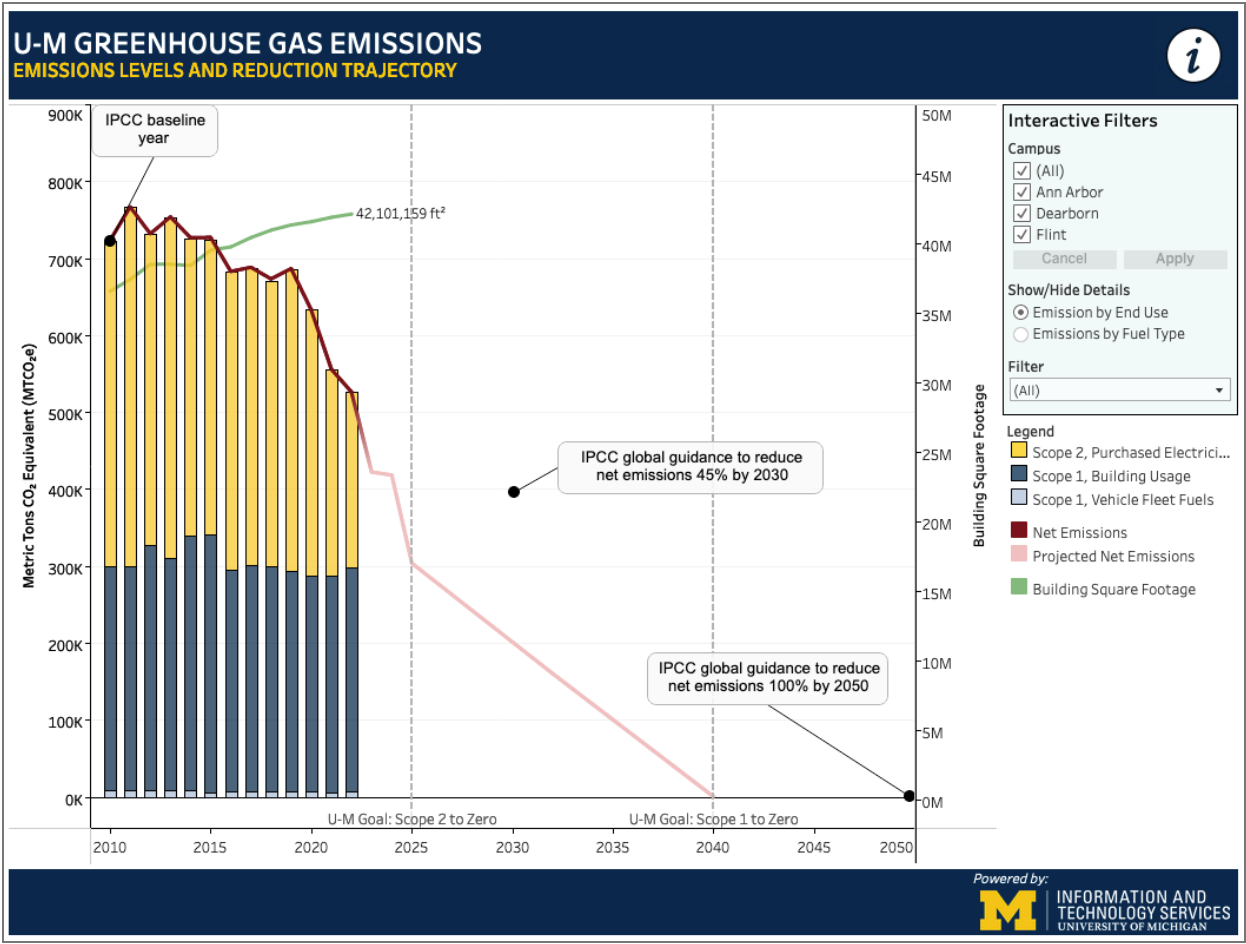Geoffrey Chatas, Executive Vice President and Chief Financial Officer
University of Michigan
University of Michigan
Add this issuer to your watchlist to get alerts about important updates.
The university has undertaken several strategies that advance its commitment to achieving carbon neutrality across the Dearborn, Flint and Ann Arbor campuses, including Athletics and Michigan Medicine.
They include a report on the use of $300 million in “green bonds,” updated sustainability dashboards and building guidelines, and becoming the first university to join the First Movers Coalition, which aims to advance sustainable industrial technologies.
“Meaningful climate action — especially at a place the size of the University of Michigan — involves a number of complementary efforts,” President Santa J. Ono said. “As we reduce our greenhouse gas emissions, enact new sustainable building standards and join leading partnerships, we’re sharing our progress to spur our campus community toward further action.”
Last month, the U-M Treasurer’s Office published an inaugural report detailing how an initial series of green bonds — funding issued for sustainable capital projects — is advancing university sustainability and carbon neutrality efforts.
“Our first issuance of green bonds is about more than getting projects in the ground — it’s about living our ideals and continuing forward on a path we have been walking for over a century,” wrote Geoffrey Chatas, executive vice president and chief financial officer.
“The $300 million in green bonds issued in March 2022 will allow us to build on our longstanding legacy of sustainability — from our first forestry class in 1881, to the launch of the U-M Biological Station in 1909, to our role in the inaugural Earth Day in 1970.”
U-M plans to allocate 91% of the bonds to sustainable construction and renovation projects, as well as 7% to renewable energy infrastructure and 2% to clean transportation.
As of March 31, nearly $8 million in green bond proceeds had been expended. Noteworthy allocations include the Hayward Street geothermal exchange installation, the Central Campus Recreation Building, electric bus procurement, a new building for the College of Pharmacy, and the recently announced new Central Campus residence hall.
The report notes that green bonds are funding efforts that advance environmental justice, with a focus on people who may be disproportionately and adversely affected by a transition to a low-carbon economy.
The Treasurer’s Office also unveiled a new interactive project map that allows users to explore sustainable projects financed by green bonds. It can be found in the university’s updated sustainability dashboards.
As sustainable investing efforts and disclosures move ahead, U-M launched an update to its greenhouse gas emissions-reduction dashboard, which tracks universitywide progress toward carbon neutrality.
Version 2.0 includes a new trendline covering the square footage of U-M buildings over time. Total university emissions have declined by more than 25% since 2010, despite a 15% increase in building space.
U-M is on pace to reduce Scope 1 and 2 greenhouse gas emissions — those that come from direct sources and purchased electricity — by 50% by 2025, exceeding United Nations Intergovernmental Panel on Climate Change guidance to reduce emissions by 45% by 2030.

U-M also unveiled a parallel dashboard — managed by the Office of the Vice President for Communications, the Office of Campus Sustainability, and Information & Technology Services — that tracks Ann Arbor campus sustainability metrics. The tool allows users to gain a quick glimpse of campus performance across an array of sustainability subtopics, including energy, greenhouse gas emissions, transportation, waste, and land and water use.
U-M community members played a key role in helping the dashboards take shape. Students taking part in an undergraduate course on “Sustainability and the Campus” recommended strategies to better visualize carbon neutrality and sustainability metrics that will inform future versions.
“Climate action requires thoughtful engagement,” said Drew Horning, interim assistant vice president for campus sustainability. “We will continually improve our progress tracking tools with community feedback, and we’re grateful for the ideas that students have recently brought to the fore.”
U-M recently became the first university to join the First Movers Coalition, a global partnership led by the U.S. State Department and the World Economic Forum, in collaboration with the U.S. departments of Commerce and Energy.
FMC includes 80 member companies, which aim collectively to send a market signal to spur sustainable technologies across seven industrial sectors that together account for 30% of global greenhouse gas emissions: aluminum, aviation, chemicals, concrete, shipping, steel and trucking.
Members endeavor to collectively build the clean and profitable supply chains of the future.
In aviation, FMC members commit to procuring sustainable aviation fuel, a biofuel made from renewable feedstocks such as used cooking oil, tallow or agricultural residues. Sustainable aviation fuel is a less-carbon-intensive alternative to conventional jet fuel, with current potential to reduce lifecycle emissions by more than 75%.
U-M previously announced a partnership with Delta Air Lines to spur the widespread adoption of sustainable aviation fuel and reduce lifecycle emissions resulting from university-sponsored travel. The university also is working within the Delta partnership to foster research collaborations involving U-M sustainable aviation experts.
In collaboration with faculty at the A. Alfred Taubman College of Architecture and Urban Planning, Facilities & Operations recently updated standards for building construction and renovation to reflect university carbon neutrality goals.
In addition to adopting maximum emissions targets, U-M design guidelines now:
With new standards in place, Facilities & Operations is implementing pilot programs centered around building air leakage testing, building envelope sealants, ongoing verification of building system performance and refined maintenance practices.